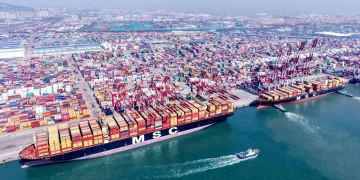In the grand tapestry of our global response to climate change, every thread is pivotal. The challenge of reducing carbon emissions demands a symphony of efforts across various industries and domains. Among these, the construction industry stands as a primary contributor to global carbon emissions. The cultivation of a green construction value chain is a strategic maneuver that promises to not only reduce emissions but also respond adeptly to the challenges of climate change.
A recent report, “Building a Green Construction Value Chain: Insights from China and Global Perspectives,” jointly released by Boston Consulting Group and the World Economic Forum, lays out a roadmap for the transformation of the global construction industry. This roadmap is aimed at addressing climate change and preserving biodiversity. The report identifies 11 strategic initiatives along the construction value chain, which, if implemented in concert, could unlock over 80% of the industry’s carbon reduction potential and unleash a market opportunity worth $1.8 trillion.
Constructing a Greener World
The construction sector is responsible for 37% of global carbon dioxide emissions, while 34% of Earth’s species face the loss of habitat due to urban development. Given the rapid pace of urbanization, especially in emerging economies, the report calls for a comprehensive and integrative approach throughout the construction lifecycle—from building and operation to decommissioning—to foster a green transformation in the global construction industry value chain.
The Vision for Green Building
The report outlines a holistic vision for green building, characterized by four distinct features: zero carbon emissions, achieved through innovative materials and technologies to minimize lifecycle emissions; nature-positive outcomes, integrating nature-based solutions to enhance environmental performance; enhanced resilience, bolstering the capacity to withstand extreme weather and climate variability; and inclusivity and human welfare, improving the well-being of occupants, fostering community development, and ensuring accessibility for all.
“The new frontier for growth and competitive edge in the construction industry lies in developing buildings that are zero-emission, nature-positive, and resilient to extreme weather impacts, while also improving community well-being and fostering human connections,” said Liang Jin Hui, Executive Director of the World Economic Forum.

China’s Pivotal Role
Notably, China, home to the world’s largest construction market and producer of over half of the global capacity in many building materials, plays a crucial role in the decarbonization of the construction industry. The green transformation of China’s construction value chain not only generates value and business opportunities domestically but also propels the development and application of green building products and services globally. “China is the largest producer and consumer of building materials in the world. We must act swiftly, leveraging China’s scale advantage to contribute to the global green construction value chain,” stated Wu Yong, President of the China Association of Building Energy Efficiency.
The Path Ahead
To realize the green transformation in the construction sector, there is much work to be done. The report suggests that while many solutions currently exist, they often lack comprehensiveness, focusing on single-issue areas such as pollution reduction, low carbon emissions, or inclusive and human-centered sustainable development. For a complete green transformation of the construction value chain, there must be a strengthened understanding of climate, environmental, and human needs, driving all stakeholders to collaborate and strive towards a greener future.


































